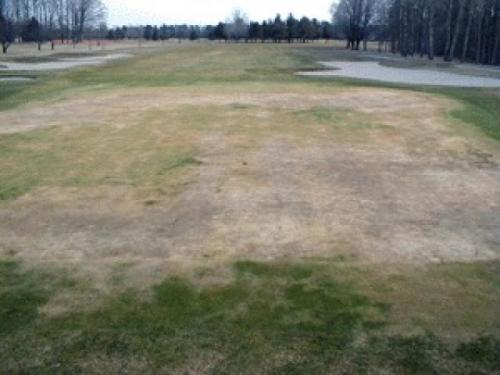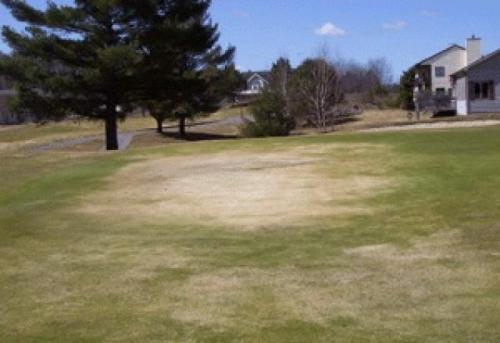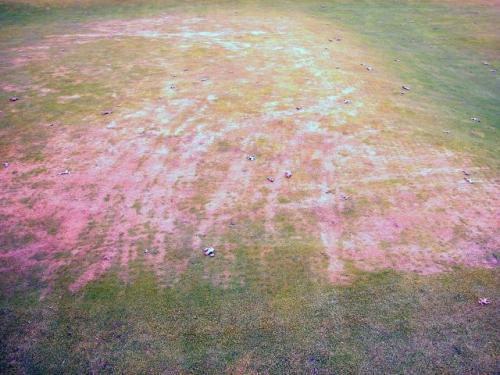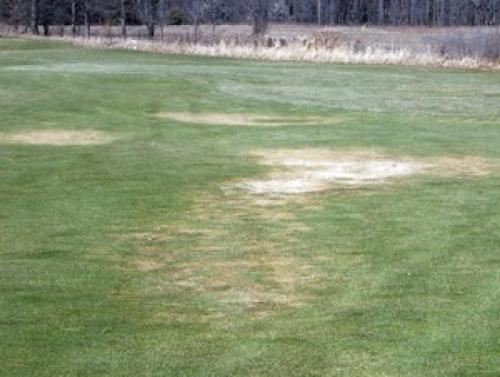Bulletin E0019TURF
Winterkill of Turfgrass
May 28, 2015 - K. W. Frank
“Winterkill” is a general term that is used to define turf loss during the winter. Winterkill can be caused by a combination of factors including crown hydration, desiccation, low temperatures, ice sheets and snow mold. Because of the unpredictability of environmental factors and differences in other factors such as surface drainage, the occurrence of winterkill on golf courses is variable and can vary greatly between golf courses and even across the same course.
Crown hydration
In general, annual bluegrass (Poa annua) greens and fairways are the most susceptible to crown hydration injury. During the warm days of late winter, annual bluegrass plants start to take up water (hydrate). Potential for injury exists when a day or two of warm daytime temperatures in late winter is followed by a rapid freeze. The most common time for winterkill associated with crown hydration and refreezing to occur is during the late winter and early spring when there is snowmelt or rainfall and then refreezing of the water that has not drained away. Crown hydration is a problem during these events because ice crystal can form in the crown of the plant, rupture the plant cells and ultimately cause the plant to die.
Annual bluegrass is more susceptible to crown hydration injury than creeping bentgrass because it emerges from dormancy and begins taking up water. Creeping bentgrass remains dormant longer and, therefore, does not take up water and is not as susceptible to crown hydration injury during the late winter.

It can be very unsettling when areas don't green up in the spring.
Desiccation
Winter desiccation is the death of leaves or plants by drying during winter when the plant is either dormant or semidormant. Desiccation injury is usually greatest on exposed or elevated sites and areas where surface runoff is great (Beard, 1973). Winter desiccation injury to turfgrass in Michigan is normally rare, though sites similar to those described above can be prone to desiccation injury on a regular basis.

Some areas are prone to collecting water.
Low-temperature Kill
Low-temperature kill is caused by ice crystal formation at temperatures below 32 degrees F. Factors that affect low-temperature kill include hardiness level, freezing rate, thawing rate, number of times frozen and postthawing treatment (Beard, 1973). Soil temperature is more critical than air temperature for low-temperature kill because the crown of the plant is in the soil. It is difficult to provide absolute killing temperatures because of the numerous factors involved. Beard (1973) provided a general ranking of low-temperature hardiness for turfgrass species that were autumn-hardened.
| Low-temperature hardiness | Turfgrass species |
|---|---|
| Excellent | Rough bluegrass |
| Creeping bentgrass | |
| Good | Kentucky bluegrass |
| Colonial bentgrass | |
| Medium | Annual bluegrass |
| Tall fescue | |
| Red fescue | |
| Poor | Perennial ryegrass |
Ice sheets
Ice sheets are often blamed for killing turf when, in fact, it is crown hydration and subsequent refreezing that has resulted in the kill. The reason for the confusion is that, as snow melts and refreezes, creating ice sheets, the ice sheets are often in poorly drained areas where crown hydration can occur because of the standing water. As the ice sheet melts away, the area damaged closely mirrors where the ice occurred, and therefore, the conclusion is that ice sheets caused the kill. Beard conducted research on ice sheets on three turfgrass species: Kentucky bluegrass, creeping bentgrass and annual bluegrass. Kentucky bluegrass and creeping bentgrass survived 150 days of ice cover without significant injury; annual bluegrass was killed somewhere between 75 and 90 days of ice cover (Beard, 1998). The author concluded that cause of death for the annual bluegrass was most likely from toxic gas accumulation under the ice sheet.

Winterkill on a putting green, exacerbated by cross country skiing.
Snow mold
The two diseases commonly called snow mold are Typhula blight (gray snow mold) and Microdochium patch (pink snow mold). Gray snow mold requires extended periods of snow cover; pink snow mold can occur either with or without snow cover. If snow mold injury is a recurring problem, preventive fungicide applications are the best control option.
Steps in recovery
To assess if damage has occurred, samples can be taken from turf areas, moved inside and placed in a warm, sunny area to see if the turf greens up. If there is no green-up within a couple of weeks, the turf was killed.
Reestablishing turfgrass in damaged areas can be very challenging in the spring because of the cool, cloudy conditions that often persist. Depending on the extent of damage, either seeding or sodding may be necessary to facilitate recovery. In areas where the turf was killed in a manner that left well-defined margins between dead and living turf, it may be feasible to strip dead turf and sod the area. In areas where the kill was more scattered, it may be easier to seed the area. Seeding can be difficult, especially on damaged areas of greens. Interseeding creeping bentgrass into dead areas on the greens has given mixed results. The best results with interseeding have occurred when the lowmow, high-density creeping bentgrasses, such as the A and G series bentgrasses, have been used. Tools such as the Job-Saver aerator attachment, which produces numerous small, shallow holes, also increase the success of an inter-seeding program. The interseeding process should continue weekly until the damaged area has completely recovered. On greens that are predominantly annual bluegrass, often it is better to scratch the surface of the dead areas to allow the annual bluegrass to germinate and fill in the voids. Keys to success for renovating winterkilled areas are to divert traffic from newly seeded areas, apply light fertilizer applications to stimulate growth, and irrigate to ensure that the seedbed or sod is moist throughout the establishment period.

Literature Cited
Beard, J.B. 1973. Turfgrass: Science and Culture. Englewood Cliffs, N.J.: Prentice-Hall.
Beard, J.B. 1998. Winter ice cover problems? TURFAX. 9(1):1-2,5.



 Print
Print Email
Email






